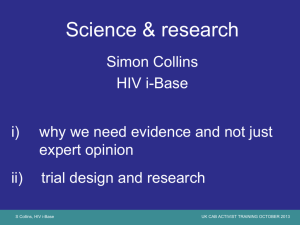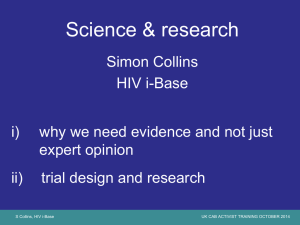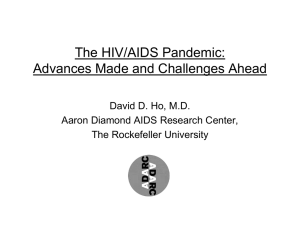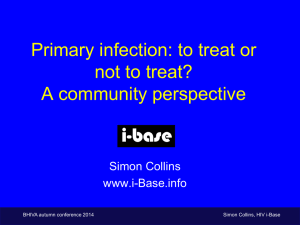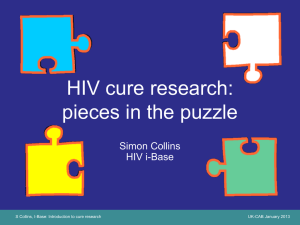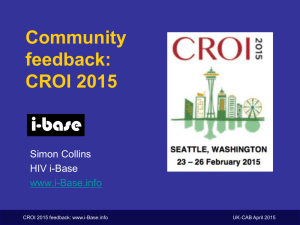CD4 and viral load Powerpoint - HIV i-Base
advertisement
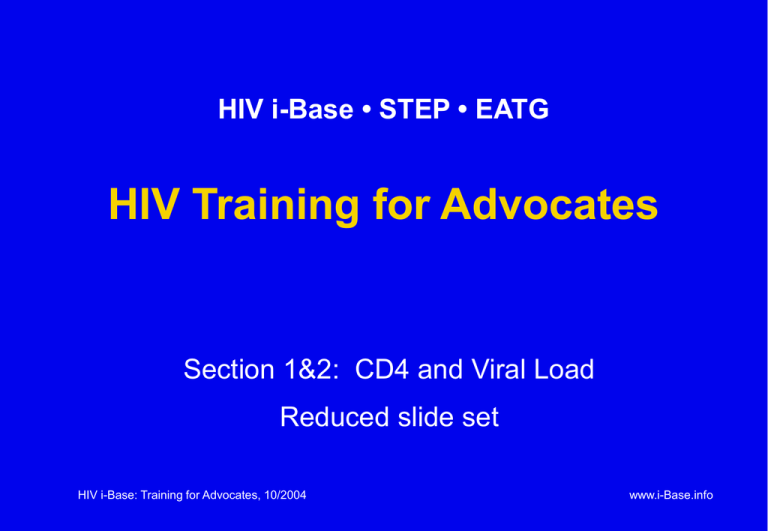
HIV i-Base • STEP • EATG HIV Training for Advocates Section 1&2: CD4 and Viral Load Reduced slide set HIV i-Base: Training for Advocates, 10/2004 www.i-Base.info CD4 count.1 • CD4 count - Marker for immune damage caused by HIV. Measured as ‘cells/mm3’ • HIV-negative range 600-1200. • Declines ~50-100 cells/year - AVERAGE • Closely matches the risk for becoming ill and used to provide prophylaxis treatment • >300 - very few HIV-related problems, except cancers (KS, NHL, lymphoma at any count). Reduced response to vaccinations. • 200–300 - water and food bourn problems (microsporidia, crytosporidia) + skin problems • <200 - PCP • <100 - MAI, MAC, toxoplasmosis • <50 - CMV + increased risk for everything else HIV i-Base: Training for Advocates, 10/2004 www.i-Base.info CD4 count.2 • Used for deciding when to start HIV treatment - historical UK (2003) - when ≥ 200 cells/mm3 - (EuroSIDA) US (2003) - when ≥350 cells/mm3 (from 2003) • Used for deciding when to stop treatment • Used to monitor and treat with prophylaxis One test result means nothing by itself - you need to follow results over time and the trend of any changes • CD4% is the % of lymphocytes that are CD4 cells - the % can be more stable than count • Other factors: smoking, time of day, exercise, fatty meal HIV i-Base: Training for Advocates, 10/2004 www.i-Base.info CD4 history after HIV infection [without treatment] Death Seroconversion Infection Asymptomatic Symptomatic AIDS 1000 CD4+ Cells/mm 500 200 0 4-8 wks 2-12 mo Up to 12 years 2-3 years Time HIV i-Base: Training for Advocates, 10/2004 www.i-Base.info CD4 history after HIV infection [without treatment] Death Seroconversion Infection Asymptomatic Symptomatic AIDS 1000 CD4+ Cells/mm3 Start treatment before CD4 goes below 200 cells/mm3 500 200 0 4-8 wks 2-12 mo HIV i-Base: Training for Advocates, 10/2004 Up to 12 years Time 2-3 years www.i-Base.info Viral load.1 (HIV RNA) 1. Measures level of virus (copies/mL) - usually in blood 2. New technology. Individualise care. Now widely used in other viral infections - (but scale of results is different) (ie with HCV is usually measure in millions) 3. Can influence when to start treatment (ie if ‘high’ >100,000 copies/mL then predictive of progression), and in choice of treatment 4. 3-fold margin of error (ie 30,000 could be anywhere between 10,000 and 90,000 and still count as the same result) 5. This is the most important test when on-treatment HIV i-Base: Training for Advocates, 10/2004 www.i-Base.info Viral load.2 (HIV RNA) When on-treatment: • viral load tests tell you if your treatment works • when your treatment fails • Whatever the starting level (baseline) - aim to get viral load to under 50 copies/mL (by3-6 months) • If still detectable resistance will develop and guidelines recommend changing treatment HIV i-Base: Training for Advocates, 10/2004 www.i-Base.info Viral load after HIV-1 Infection [without treatment] Death Seroconversion Infection Asymptomatic Symptomatic AIDS 2 million viral load copies/mL 0 4-8 wks 2-12 mo Up to 12 years 2-3 years Time HIV i-Base: Training for Advocates, 10/2004 www.i-Base.info Viral load after HIV-1 Infection [without treatment] Death Seroconversion Infection Asymptomatic Symptomatic AIDS 2 million 1000 CD4+ Cells/mm3 viral load copies/mL 500 200 0 0 4-8 wks 2-12 mo Up to 12 years 2-3 years Time HIV i-Base: Training for Advocates, 10/2004 www.i-Base.info After HIV treatment (ARVs): effect on CD4 and viral load Start treatment Viral load <50 copies/mL 2 million 1000 CD4+ cells/mm3 viral load (RNA) copies/mL 500 200 < 50 copies/mL 0 0 + 1-40+ years !! 1-12 yrs +1-6 mo Chronic Infection HIV i-Base: Training for Advocates, 10/2004 Time www.i-Base.info
